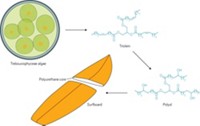Advertisement
Grab your lab coat. Let's get started
Welcome!
Welcome!
Create an account below to get 6 C&EN articles per month, receive newsletters and more - all free.
It seems this is your first time logging in online. Please enter the following information to continue.
As an ACS member you automatically get access to this site. All we need is few more details to create your reading experience.
Not you? Sign in with a different account.
Not you? Sign in with a different account.
ERROR 1
ERROR 1
ERROR 2
ERROR 2
ERROR 2
ERROR 2
ERROR 2
Password and Confirm password must match.
If you have an ACS member number, please enter it here so we can link this account to your membership. (optional)
ERROR 2
ACS values your privacy. By submitting your information, you are gaining access to C&EN and subscribing to our weekly newsletter. We use the information you provide to make your reading experience better, and we will never sell your data to third party members.
Business
Paints From Plants
With biobased-coatings raw materials, companies get more than just independence from petroleum
by Alexander H. Tullo
April 12, 2010
| A version of this story appeared in
Volume 88, Issue 15

Coatings incorporating nature-derived raw materials aren’t new. Until the 20th century, paints and varnishes based on ingredients such as linseed oil and turpentine were the norm, and they are still fairly common. But as with many natural materials over the past 100 years, those ingredients have been overtaken by petroleum-derived compounds, and today acrylics, polyesters, and polyurethanes are preeminent in coatings.
Now, some chemical companies are aiming to reverse this longtime trend. They have honed the tools of chemistry on raw materials drawn from natural oils and sugars and are trying to introduce the compounds back into paints. Their motivation is largely about depending less on fossil fuels. But the firms want to accomplish more than just selling adequate biobased substitutes. They aim to offer benefits to paint formulators that aren’t attainable with petroleum-based raw materials, including realizing long-held goals of the paint industry such as reducing volatile organic compound (VOC) content.
Vijay Mannari, a professor of polymers and coatings technology at Eastern Michigan University, says the new biobased coatings ingredients tend to impart the properties of the natural materials from which they are derived. This tendency can either be an advantage or a drawback. For instance, a raw material made from a hydrophobic fatty acid can lend the paint good water resistance. The fatty acid also improves wetting properties by reducing the surface tension of the formulation.
On the other hand, Mannari says, coatings with fatty acids can degrade or yellow when heated or exposed to ultraviolet light. And because they are natural, biobased raw materials do not have as consistent a composition as do petroleum-based raw materials. However, “with the proper chemistry, you can definitely overcome some of these limitations,” he says.
The new generation of biobased-paint raw materials is starting to attract major attention. Procter & Gamble and Cook Composites & Polymers (CCP) won a Presidential Green Chemistry Challenge Award from the Environmental Protection Agency last year for their use of P&G’s Sefose line of sucrose esters to reduce the VOC content of alkyd paint formulations (C&EN, June 29, 2009, page 5). Alkyds are reaction products of vegetable oils, phthalic anhydride, and polyols such as glycerin.
Sucrose esters are the product of attaching eight fatty acids derived from vegetable oils onto a central sucrose molecule. The P&G chemistry used to make the compounds has well-known origins in the production of olestra, a dietetic fat substitute based on the idea that if a fatty molecule is large enough, people won’t be able to digest it. In the late 1990s, P&G incorporated olestra into fat-free snacks such as Frito-Lay Wow! potato chips. However, a Food & Drug Administration label warning of “abdominal pain and loose stools” dampened consumer reception until the tag was removed in 2003.
At around the same time, P&G started investigating industrial applications for the chemistry, which it formally branded as Sefose for the effort, says Robert J. Enouen, P&G’s commercial leader for Sefose and associate director for customer business development. Sefose, he explains, uses sucrose and soy-based fatty acids with molecular weights and levels of saturation different from those in olestra. “Sefose is a very tunable platform,” he says. “It can exist in different forms with different chemical properties.”

The effort in coatings was more the result of a serendipitous discovery than a reaction to how olestra was faring with food consumers, Enouen says. “Our lab scientists had noticed that when Sefose was left out to dry overnight, it created a film,” he explains.
About five years ago, P&G contacted paint resin specialist CCP to explore the potential of Sefose. Dennis Ryer, product manager for liquid and powder resins at CCP, was technical director at the time. He says scientists started blending Sefose with alkyd resins. The first formulations that the company made had trouble drying. “We were great at making flypaper,” he recalls.
P&G adjusted the Sefose molecules, and CCP developed a new alkyd resin, Chempol MPS, for use with it. Alkyd resins based on the combination have biobased content from both the initial alkyd resins and Sefose, but the benefit of the technology is that it reduces VOCs in alkyd paints. Because Sefose has a molecular weight of 3,000 g/mol, and alkyd resins have molecular weights of between 30,000 and 60,000 g/mol, incorporating the sucrose derivative reduces the viscosity of the overall resin formulation, Ryer says. That, in turn, decreases the solvent required to thin the paint. At the same time, the spider-shaped Sefose molecules form an intricate cross-linking network with the alkyd.
The present generation of the technology has enabled the reduction of VOCs in standard alkyd paints from 440 g/L to less than 250 g/L. And CCP and P&G are working on an emulsion that takes VOCs down to about 30 g/L, making the Sefose/alkyd paints comparable to acrylic latex.
Coatings incorporating Sefose have good water resistance and adhesion because of the high concentration of fatty acids, Ryer says. Those qualities are an advantage in some target wood-coatings markets, such as floor coatings and decorative trim, he adds.
Ryer hopes that, eventually, the Sefose/alkyd paint combination will reverse the trend of acrylic latex taking market share away from alkyds because of the VOC issue. “It revolutionizes our product line,” he says.
Reducing VOCs is also one of the ideas behind Solus, a line of cellulose esters Eastman Chemical introduced in 2007. Cellulose esters have been used in coatings for decades as a co-resin in applications such as automotive coatings. But their use ebbed in the 1980s and ’90s because of concerns over VOCs, says Deepanjan Bhattacharya, coatings innovation leader at Eastman.
To make the Solus products, Eastman esterifies cellulose with acetic and butyric anhydrides. Solus compounds can be incorporated in two-part acrylic-polyester blends by reacting them with melamine and urethane cross-linking agents for applications such as automotive and aerospace coatings.
Incorporating Solus compounds can reduce VOC content by as much as 50%, the company says. “Normally, there is a trade-off when you substitute some of the petrochemical-based materials with biobased sources,” Bhattacharya says. With the Solus technology, however, there are no such trade-offs, he adds.
Hexion Specialty Chemicals aims to reduce manufacturing costs for customers with its biobased offering for the powder coatings industry. Last summer, the company launched Albecor-Bio, a polyester resin with up to 70% biobased content.
Maurizio Crippa, Hexion’s business director for powder resins in Europe, the Middle East, and Africa, won’t give many details about the chemistry of Albecor-Bio. He will say, however, that it involves soy-based diols that replace neopentyl glycol and trimethylolpropane in the reaction with isophthalic and terephthalic acids to make the polyester resins. The technology is employed in transportation and architectural applications such as metal screen doors and window frames.
The key environmental benefit of Albecor-Bio isn’t necessarily the biobased content, Crippa says. It is energy savings. Although standard polyester resins typically cure for about 15 minutes at around 180–200 °C, Albecor-Bio-based paints cure near 150 °C in about the same amount of time, Crippa explains. The lower curing temperature results in 25% savings in energy consumption when natural gas is used to heat the oven. In addition, manufacturers can apply the coatings to a wider variety of substrates, such as high-temperature polymers and medium-density fiberboard, than is possible with other powder coatings.
The technology, Crippa says, also looks better than standard polyester powder coatings. “You get a better flow, resulting in a prettier appearance on the substrate,” he says. Because of the advantages, Hexion is aiming for a 30 to 40% price premium for the Albecor-Bio products versus standard polyesters.
In terms of drawbacks, Crippa admits, the current “outdoor durability, in some cases, isn’t what we would like to see.” But he notes that that might not matter as much for interior applications and products not meant to last for decades, such as outdoor furniture.
Saving energy for customers was also Huntsman Corp.’s aim when it launched its line of Jeffsol glycerin carbonate. The product is made from glycerin, which has been plentiful in recent years as a coproduct of the transesterification conversion of triglycerides to biodiesel.
The product is an addition to Huntsman’s alkylene carbonates, which include ethylene and propylene carbonate. But its appeal to the company isn’t merely as another biobased product. Instead, Huntsman was intrigued by a hydroxyl group in glycerin carbonate that the other carbonates didn’t have. That extra hydroxyl allows it to be used as a blocking agent in polyurethane coatings, says Nick Kob, market development manager for performance products at Huntsman.
Blocking agents prevent the isocyanates in polyurethane from cross-linking until required. With the usual blocking agent, caprolactam, polyurethanes need to be cured at 150 °C because the blocker needs to be physically detached before cross-linking can occur. With the glycerin carbonate, however, curing can take place at 100 °C. At that temperature, the carbonate ring opens and allows cross-linking to proceed. This leads to energy savings in applications such as wire coatings.
Companies have also been interested in incorporating biobased content into polyurethanes via polyols. Huntsman has a line of soy-based polyols that it has made hydrophilic for use with waterborne coatings.

Eastern Michigan’s Mannari has been developing his own polyols. He starts with epoxidized soybean oil, which is commercially available as a “flexibilizer”—an additive that imparts flexibility—for polyvinyl chloride resins. He uses an acid to reduce the epoxy rings and then polymerizes the triglycerides together to make a polyether polyol.
These materials can replace conventional petroleum-based polyols in polyurethane coatings. He says that the soybean-oil-derived polyols have better water resistance than conventional ones.
Mannari has also been able to react epoxidized soybean oil with acrylic acid to make acrylic oligomers for radiation-cured coatings with 50 to 60% biobased content. Radiation curing is gaining ground because it uses less energy than oven curing. Mannari thinks that aligning the biobased materials with a fast-growing coatings technology has some appeal. “If you want to make more biobased raw materials the materials of choice, you have to find ways to use them in the current advanced technologies,” he says.
A biobased additive sometimes isn’t aimed at secondary environmental benefits but rather at improving the performance of the coating itself. Croda has an epoxy-modifier additive meant to do just that. According to William H. McNamee, Croda’s technical manager for polymers and coatings, the company’s Priplast additive contains C36 dimers of C18 fatty acids made by reacting unsaturated bonds. The dimers retain the carboxylic acid groups at each end of the fatty acid, which then react with epoxy resins.
The resulting resin then has two segments: a soft segment composed of the long fatty acid chain and a hard segment of epoxy resin. The fatty acid thus toughens and makes the final paint film more flexible.
As an epoxy modifier, the Croda additive substitutes for carboxyl-terminated butadiene-acrylonitrile. McNamee says Croda’s modifier has advantages in its weather resistance and durability at low temperatures. Uses for coatings incorporating the materials include marine applications and paints used inside school buildings because of “the finger marks and the abuse the coatings get from kids,” he says.
For Croda, which has its roots in wool-derived lanolin and uses biologically sourced raw materials for a vast majority of its products, the main appeal of the technology was its performance, not its origins, McNamee says. “The value in use was our aim because we saw a need in the epoxy industry for the toughening and flexibilization,” he explains. “The material being biobased was an added benefit.”
The secondary appeal of biobased raw materials is a sentiment shared by David Hester, global business development director for Huntsman’s performance products business. “Few people buy things because they are biobased,” he says. “They buy them because there is an advantage to formulating with them. What we have come to realize is that if the biobased aspect is all there is to your value proposition, it is a pretty weak value proposition.”








Join the conversation
Contact the reporter
Submit a Letter to the Editor for publication
Engage with us on Twitter